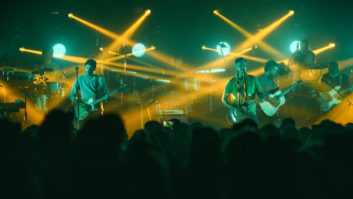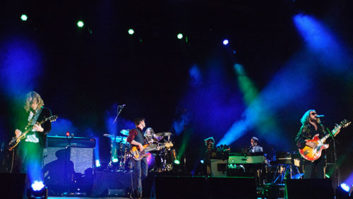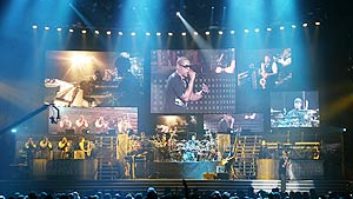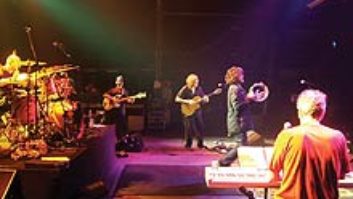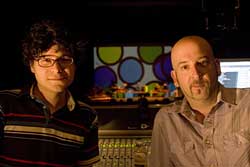
Other than a handful of live appearances and releasing a collection of B-sides and rarities, Bright Eyes kept mostly to themselves last year—hibernating from a very busy 2005, which saw the release of sister albums Digital Ash In a Digital Urn and I’m Wide Awake, It’s Morning. This year, the group unleashed a more sophisticated album, Cassadaga, which finds producer/multi-instrumentalist Mike Mogias and brainchild/singer/songwriter Conor Oberst—along with Nate Walcott (trumpet/piano); percussionists Shane Aspegren, Clark Baechle, Jonathan Crawford and Dan Bitney; drums/vocalist Jason Boesel; bassist Stefanie Drootin; and a cast of top-notch musicians—getting into their groove—a whimsical, but sturdy, bluegrass with pop inflections swirling around a heavily miked string section and killer vocals.
Front-of-house engineer Jacob Feinberg and monitor engineer Simon Wring
Touring in support of their latest, the band played to an enthusiastic crowd in Berkeley, Calif.’s Greek Theater (where Gillian Welch opened!), where Mix caught up with front-of-house engineer Jacob Feinberg, who has been mixing for the ensemble since Halloween of 2002, and monitor engineer Simon Wring, who has engineered for the band for the past seven years.
How do you find mixing for both Gillian and the band?
Feinberg: It’s a completely different approach and mindset for each to achieve the same objective: get a talented songwriter’s lyrics and music across to the audience. Gillian’s sound requires complete finesse and somewhat passiveness to allow her and David’s pure tone to come through. They have five inputs, all [Shure] 57s and 58s, and do not require any compression and very minimal EQ. Bright Eyes has 60 inputs and I use a large array of dynamics and EQ to mix all 12 musicians onstage. It can be a challenge to switch my frame of mind between the styles during the 20-minute change-overs.
Wring: Gill and Dave use two acoustic guitars with Shure 57s on them and two Shure 58s on their vocals. It’s a little tricky getting lots of volume for them as the band normally plays on their own, but with a little wringing out we get there. They are lovely people and make such a great sound, which makes it a pleasure to mix.
What kind of board are you using?
Feinberg: I’m using a Digidesign D-Show console with all onboard effects and inserts; no outboard at all. I’ve been using the McDSP MC4000 multiband compressor a ton for everything from vocals to violin.
Wring: I’m using a Yamaha PM1D as we are running so many inputs, nearly 70 at this point. I’m using the onboard effects, a little reverb/delay and sending the FOH effects through the talkback channel. I’m not a big believer in over-processing mixes if the source sound is good, and it is with this band. I’m also using the compressors on the PM1D, which sound good especially on some of the acoustic instruments. I’m not so happy with the gates, so I’m avoiding them when I can.
How many mixes are you doing?
Feinberg: We’re up to 60 inputs, which is a new high for Bright Eyes. That’s 12 musicians, plus guests, including a 4-part string section, two woodwinds, two drummers and a percussion setup, full keyboards, guitars, bass and several vocals. It amounts to 45 open microphones.
Wring: I’m running 12 mixes, nine are wireless and three are hardwired. Most are stereo, so I’m able to give them a good audio image of the stage if they need it. I have different starting points depending on the size of room and we adjust from there. The most difficult thing has been using the Isomax microphones on some of the string section. They sound great but pick up so much sound off the P.A., even using hard EQ, and the highpass filter on the PM1D we’ve had a few problems, so some of the strings are using pick-ups and I EQ to the room. We also have a few wedges running certain mixes in case we have any frequency problems during the set and to add some “feel” to the stage.
That’s a lot of sound coming off the stage? What P.A. are you using?
Feinberg: We’re using the d&b J Series J8s and J12s for the main hang. We’ve got B2s running in CSA mode and Q1s and Q10s for fills. It’s an all-digital control signal chain with the Dolby Lake Processors at the heart of it. We time-align and tune with [SIA] Smaart, but find that we do the same very minimal EQ cuts each day regardless of venue. Some of our tuning is done using Rope, the d&b control software, to adjust the HFC and CPL settings for the Js. This provides a more cohesive EQ approach.
Alright, I can’t let the “45 open mics” go by. What kind of mics are you using?
Feinberg: For vocals, we have my favorite Sennheiser 935s across the board. The strings are using the Countryman IsoMax small-diaphragm condensers, and the clarinet is on a Sennheiser 441. There’s a large variety of Sennheiser (602 and 604s), Shure (57, Beta 57), AKG (414s) and Neumann (184s) on the drums and percussion. I’ve got a cheap Apex 105 ribbon mic on Conor’s guitar amp that a Canadian engineer friend turned me on to.
Do you have a specific mixing style for Bright Eyes, especially with them touring with a full band?
Feinberg: Conor’s vocal comes first as his lyrics are the main focus of his audience. Beyond that, it’s always my goal to allow an audience member to be able to look at any single musician or instrument onstage and be able to pick them out from the mix at any time. Bright Eyes changes their lineup for every tour, so I try and keep a consistent sound and tone for the group over the years, even though almost everyone in the band, as well as instrumentation, changes from tour to tour. Whether it’s a string section, harp, vibes, double drummers, backing tracks, et cetera, it should always sound like Bright Eyes.
Wring: It’s always fun mixing Bright Eyes as it’s only ever the three core members—Conor Oberst, Mike Mogis and Nate Walcott—that are constant, so the instrumentation changes all of the time, so my mixing style has to adapt to the band. All the musicians are experienced and let me know what they need during the show and we have regular chats to see how we can make it the best it can be.
It’s nice to know you’ve got the support of sound company Eighth Day Sound.
Feinberg: They’ve been amazing supplying the best gear and support, as well as excellent techs. Our last tour we did without any techs since the budget didn’t allow for it, but the show required that we carry production. This tour has been a huge improvement as we’ve asked Eighth Day to supply an FOH/system tech, Demetrius Moore, and a monitor/stage tech, Alfonso Rettich. They’ve been great, and needless to say it’s been very helpful.
Wring: We have Brent Lind running stage and is a superb drum tech, and Philip Schaffart taking care of all the bands’ guitar needs. All these “cats” are the best and I would recommend them to anyone looking for people to tour with. Jacob makes Bright Eyes sound amazing and takes care of all our production so well; I feel privileged to be part of this lovely crew and to work with this very special band.
LISTEN: Must Play
Four Winds
